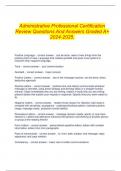Administrative Professional Certification
Review Questions And Answers Graded A+
2024-2025.
Positive Language - correct answer. can be done, read or hear things from the
positive point of view, Language that creates goodwill and gives more options to
receivers than negative language.
Tone - correct answer. your communication
Goodwill - correct answer. major concern
Positive Letters - correct answer. yes to the message receiver, can be done, direct,
deductive approach
Routine Letters - correct answer. positive tone and clearly communicate whatever
message is intended, using direct strategy and develop ideas in a straight forward
manner. State immediately why you are writing, explain in body why you are writing,
present details that explain your request or response. Specify what you want reader to
do
Negative Letters - correct answer. reader knows reason for rejection, bad news is
revealed with sensitivity, acceptance - understand/indirect pattern, maintain positive
image, message clarity, protection (avoid liability)
Persuasive Letters - correct answer. message-receiver needs, wants, or may have
interest in, Letters that attempt to influence the behavior and thinking of another person
or group at the reading thereof
Form Letters - correct answer. personalized repetitive letters, letters with variable
information, letters from form paragraphs
Parts of memoranda - correct answer. to, from, date, subject, and message, reply,
signatures, and copy notation
Consistency - correct answer. basic rule of written communications
,Abstracting Techniques - correct answer. photocopying and highlighting key points,
preparation of a summary of key points in a document (such a summary in paraphrased
from is called a précis)
Primary Data - correct answer. Original documents, information from files, interviews,
questionnaires, personal observations, research studies, Facts collected specifically for
the problem or project at hand.
Secondary Data - correct answer. publication already in print (books, magazines,
pamphlets, etc.), Information that already exists somewhere, having been collected for
another purpose
Reports are made up of the following - correct answer. Prefatory Parts
Introduction
Body
Summary
Supplementary Data
Prefatory Parts of a report - correct answer. cover, title fly, title page, letter of
authorization, letter of transmittal, table of contents, table of tables, and abstract
Introduction of a report - correct answer. presents information about the authorization
for the report
Body of a report - correct answer. explanation and presentation of data, the bulk of the
report or proposal.
Summary, conclusion of a report - correct answer. Summary of the report
Supplementary Data/Appendices of a report - correct answer. Appendix, bibliography,
and index
Direct Approach - correct answer. The direct approach anticipates no resistance to its
message--for instance, "you've been hired," "your order is being shipped today," or even
"the project will be done in one week."
In this case, organizing your message is simple. Memos and letters should have some
kind of brief introduction, sometimes as its own paragraph. The introduction is simply a
straightforward statement of the main point of the message. For instance, if you are
writing a letter to confirm an order, simply begin by stating, "We have received your
order and are shipping it today." Then the rest of the letter can provide details like
shipping time, cost, etc.
,Whenever possible, use the direct approach. Most readers are in a hurry and want the
main point up front. And if there's no reason for them to respond negatively, there's no
reason to delay that main point.
Keep in mind that the direct approach applies equally to letters, memos, and e-mail
messages
Indirect approach - correct answer. Sometimes, your letter, memo, or e-mail message
contains "bad news" of some type. One that strategically delays the bad news until your
reader has been prepared to accept or deal with it in a positive way.
In this instance, organizing your message can be a bit more complicated and call for a
bit more strategy. Think of situations in which you've had to communicate bad news
orally.
Now be careful with buffers. What you don't want to do is create the impression that
you're stalling or attempting to hide the negative message. If there is bad news to
communicate, you have to be honest in communicating it and you need to get to it in a
way that doesn't waste your reader's time. However, a well-placed paragraph, sentence,
or just a phrase can go a long way toward softening the blow and helping readers
realize that even though the news is bad, you still have their best interests in mind.
Deductive Reasoning - correct answer. Deductive and inductive refer to two distinct
logical processes. Deductive reasoning is a logical process in which a conclusion drawn
from a set of premises contains no more information than the premises taken
collectively. All dogs are animals; this is a dog; therefore, this is an animal: The truth of
the conclusion is dependent only on the method. All men are apes; this is a man;
therefore, this is an ape: The conclusion is logically true, although the premise is
absurd.
Inductive Reasoning - correct answer. Inductive reasoning is a logical process in
which a conclusion is proposed that contains more information than the observations or
experience on which it is based. Every crow ever seen was black; all crows are black:
The truth of the conclusion is verifiable only in terms of future experience and certainty
is attainable only if all possible instances have been examined. In the example, there is
no certainty that a white crow will not be found tomorrow, although past experience
would make such an occurrence seem unlikely.
Logical Format - correct answer. (inductive or indirect) Introduction, body, terminal
section
Psychological Format - correct answer. (deductive or direct) Terminal Section,
Introduction, Body OR Introduction, Body, Terminal Section
Short Reports: - correct answer. to, from, date, subject line, introduction, text, terminal
section (conclusion) appendix; Used to expedite interoffice reporting communication in
, the following areas: informational memo reports, analytical memo reports, and
standardized, printed form reports, letter reports, annual & progress reports, short report
proposals, justification reports, recommendation reports, feasibility studies
Information Reports - correct answer. present data without providing an analysis or
recommendations. Designed to inform specific individuals of facts and particulars with
regard to the subject, offer data, facts, feedback, and other types of information, without
analysis or recommendations.
Analytical Reports - correct answer. provide information, analysis, conclusions, and
recommendations, Includes both information and analysis and can also include
recommendations
Standardized Form Reports - correct answer. specific details with regard to on-going
projects and programs in an organization
Progress Reports - correct answer. Also known as status reports, keep the reader
informed about activities, problems, and progress related to a large project. Large
projects may require regular submission of reports-daily, weekly, or monthly.
Justification reports - correct answer. provide information, optain evaluations, and
recommendations submitted to the individual who authorized the report's creation,
explain or recommend something, such as the need for a purchase, an investment,
additional staff, or a change in procedure or structure. Briefly provides background of
the situation, introduces the recommendation(s), stresses the benefits of the action, and
adds specifics.
Minutes - correct answer. coverage of meeting proceedings, A summary of the events
and business conducted during a meeting. The official record of a meeting and are kept
by the secretary of an organization.
Summaries - correct answer. consolidate and condense main conclusions, concepts,
and ideas found in longer documents
Outline for a report - correct answer. include important points to cover and provide
basic framework for report compilation
Formal Reports - correct answer. written from a third-person's point of view,
contractions are not used (did not instead of didn't) and the passive voice approach is
used; Use a formal writing style. Basic Outline: prefatory section, report body, terminal
portion, and supplementary portion
Footnotes - correct answer. use raised numbers in the text that match with footnote
references listed on the bottom to the same page; footnotes can also be listed
numerically on separate pages at the end of the document





